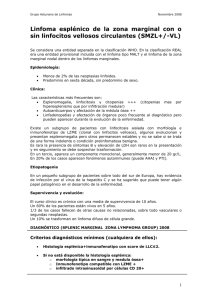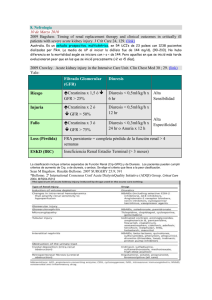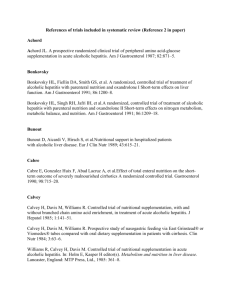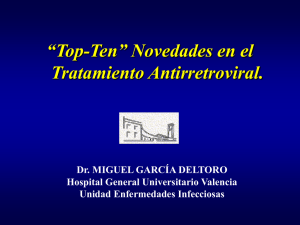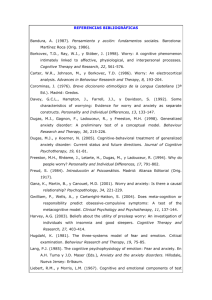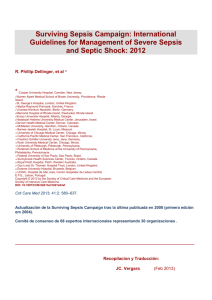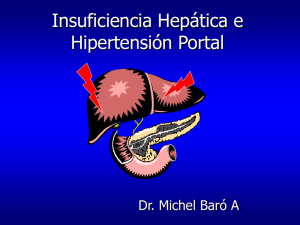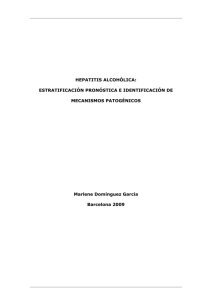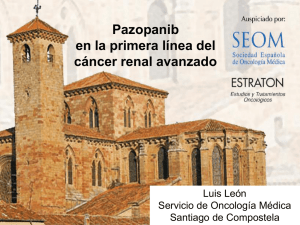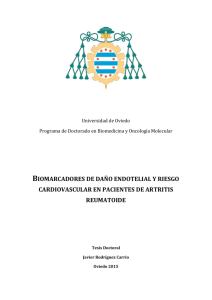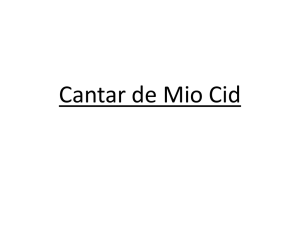3rd INTERNATIONAL SYMPOSIUM ON OZONE APPLICATIONS
advertisement
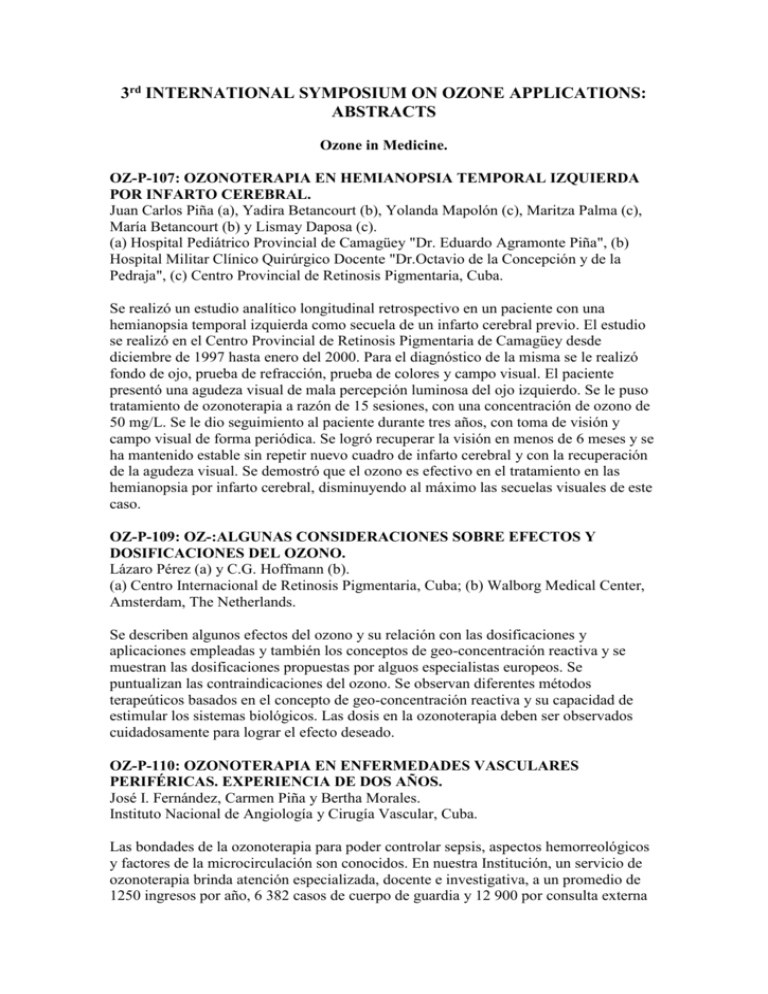
3rd INTERNATIONAL SYMPOSIUM ON OZONE APPLICATIONS: ABSTRACTS Ozone in Medicine. OZ-P-107: OZONOTERAPIA EN HEMIANOPSIA TEMPORAL IZQUIERDA POR INFARTO CEREBRAL. Juan Carlos Piña (a), Yadira Betancourt (b), Yolanda Mapolón (c), Maritza Palma (c), María Betancourt (b) y Lismay Daposa (c). (a) Hospital Pediátrico Provincial de Camagüey "Dr. Eduardo Agramonte Piña", (b) Hospital Militar Clínico Quirúrgico Docente "Dr.Octavio de la Concepción y de la Pedraja", (c) Centro Provincial de Retinosis Pigmentaria, Cuba. Se realizó un estudio analítico longitudinal retrospectivo en un paciente con una hemianopsia temporal izquierda como secuela de un infarto cerebral previo. El estudio se realizó en el Centro Provincial de Retinosis Pigmentaria de Camagüey desde diciembre de 1997 hasta enero del 2000. Para el diagnóstico de la misma se le realizó fondo de ojo, prueba de refracción, prueba de colores y campo visual. El paciente presentó una agudeza visual de mala percepción luminosa del ojo izquierdo. Se le puso tratamiento de ozonoterapia a razón de 15 sesiones, con una concentración de ozono de 50 mg/L. Se le dio seguimiento al paciente durante tres años, con toma de visión y campo visual de forma periódica. Se logró recuperar la visión en menos de 6 meses y se ha mantenido estable sin repetir nuevo cuadro de infarto cerebral y con la recuperación de la agudeza visual. Se demostró que el ozono es efectivo en el tratamiento en las hemianopsia por infarto cerebral, disminuyendo al máximo las secuelas visuales de este caso. OZ-P-109: OZ-:ALGUNAS CONSIDERACIONES SOBRE EFECTOS Y DOSIFICACIONES DEL OZONO. Lázaro Pérez (a) y C.G. Hoffmann (b). (a) Centro Internacional de Retinosis Pigmentaria, Cuba; (b) Walborg Medical Center, Amsterdam, The Netherlands. Se describen algunos efectos del ozono y su relación con las dosificaciones y aplicaciones empleadas y también los conceptos de geo-concentración reactiva y se muestran las dosificaciones propuestas por alguos especialistas europeos. Se puntualizan las contraindicaciones del ozono. Se observan diferentes métodos terapeúticos basados en el concepto de geo-concentración reactiva y su capacidad de estimular los sistemas biológicos. Las dosis en la ozonoterapia deben ser observados cuidadosamente para lograr el efecto deseado. OZ-P-110: OZONOTERAPIA EN ENFERMEDADES VASCULARES PERIFÉRICAS. EXPERIENCIA DE DOS AÑOS. José I. Fernández, Carmen Piña y Bertha Morales. Instituto Nacional de Angiología y Cirugía Vascular, Cuba. Las bondades de la ozonoterapia para poder controlar sepsis, aspectos hemorreológicos y factores de la microcirculación son conocidos. En nuestra Institución, un servicio de ozonoterapia brinda atención especializada, docente e investigativa, a un promedio de 1250 ingresos por año, 6 382 casos de cuerpo de guardia y 12 900 por consulta externa en igual periodo y se prioriza la atención primaria, con un registro de 2 165 casos en 1999. En los 2 años evaluados, el Departamento de Ozonoterapia asistió a un total de 1282 pacientes, los cuales recibieron 9 790 tratamientos, siendo el método más utilizado la vía rectal. El pie diabético constituyó la patología más atendida, siguiéndole en orden las úlceras de etiología venosa. La ozonoterapia constituye en nuestro centro una de las armas terapéuticas de mayor significación para el tratamiento de pacientes. OZ-P-111: USO DEL OZONO EN AFECCIONES VASCULARES PERIFÉRICAS. Esther L. Torres, Rubén T. Moro, Ivia Jiménez y Yeisy Aguilera. Hospital Provincial Universitario "Celestino Hernández Robau", Villa Clara, Cuba. Las enfermedades vasculares periféricas tienen una alta repercusión en la población que las padece, tanto desde el punto de vista personal como social. Su cronicidad obliga a estos pacientes al contacto permanente con los servicios de salud, siendo sus secuelas graves, pudiendo ir desde ulceras crónicas, deformidades, hasta la pérdida de una pierna. Su tratamiento es muy variado y de gran importancia tanto en su profilaxis, como en las medidas terapéuticas y (o) quirúrgicas. La utilización del ozono como agente terapéutico en estas patologías ha demostrado ser un instrumento útil, económico y necesario dentro de los recursos del angiólogo y del cirujano vascular. Este estudio descriptivo contó con 1153 pacientes, tratados con ozonoterapia en el período de 1 año, por diferentes patologías angiológicas, con el objetivo de analizar la utilización de este gas como agente terapéutico en Angilogía y su utilidad en el tratamiento ambulatorio de dichos pacientes. El método aplicado fue la administración diaria de ozono por vía rectal, (con una concentración entre 40 - 50 mg/L), en un período de 15 sesiones. Se obtuvo como resultados una disminución en el número de amputaciones, una mejor y más rápida cicatrización de las lesiones ulcerosas, así como la curación de la linfangitis. Se evaluó el resultado del tratamiento como satisfactorio en más del 80 % de los pacientes tratados, con una disminución marcada del número de ingresos y del promedio de estadía en estos pacientes. Estos resultados constituyen una evidencia clara de lo positivo que ha resultado la aplicación de esta terapéutica en el campo de la Angiología. OZ-P-112: LA OZONOTERAPIA EN ALGUNAS VIROSIS CUTÁNEAS. Jorge R. Delgado, Rolando Wong, Alejandro Noriega y María de los Angeles Molina. Centro de Investigaciones Medico Quirúrgicas, Cuba. Las afecciones cutáneas de etiología viral se presentan en un gran número de pacientes de la población general y también en nuestro medio se observa con mucha frecuencia. Diferentes autores coinciden en señalar que en muchos de estos pacientes se aprecia una depresión en el sistema inmunitario. Conociendo que el ozono además de la acción virucida tiene efectos inmunomoduladores, se llevó a efecto este estudio, en 84 pacientes que recibieron tratamiento con ozono por diferentes vías. Todos los casos diagnosticados como herpes simple se clasificaron, según la localización de la lesión, en genital, labial, y glútea, utilizándose la vía subcutánea simultáneamente con la aplicación tópica de aceite ozonizado, y para el herpes zoster (20 pacientes) solamente se utilizó la vía intramuscular. Podemos plantear que el ozono es efectivo para tratar estas patologías con resultados satisfactorios sobre todo en el herpes simple recidivante que, administrando el ozono por vía subcutánea, se logra controlar la enfermedad. OZ-P-113: EXPERIENCE IN USING OZONETHERAPY TECHNOLOGIES IN MEDICAL INSTITUTIONS OF RAILWAY HEALTH SERVICE. V. M. Kaznin, S. P. Peretyagin, F. S. Layenko, S. E. Kvasov, V. S. Yandyganov, V. N. Kuleshin, N. A. Mironov, V. N. Grechko and I. A. Kalashnikova. Railway Health Service, Russian Association of Ozonetherapy, Nizhny Novgorod, Russia. For the introduction of ozone therapy technologies into the broad practical health care it is necessary to substantiate and sum up the experience of ozone applications in various medicoprophylactic institutions. In 32 medical institutions of the Railway Health Service ozone therapy has been used since 1994. Now the efficiency of the ozone therapy method is being tested for various subdivisions of medicoprophylactic institutions. The introduction of ozone therapy technologies into medical practice led to reconstruction of medical institutions, formation of new subdivisions which make it possible to perform ozone treatments (ozone therapy department or room) as well as to form health data bank for testing the quality and efficiency of ozone therapy used in different categories of patients. Practical use of methods of ozone therapy makes it necessary to work out normative documentation, to compile professional requirements for ozone therapeutists, as well as to provide medical staff for ozone therapy subdivisions. Every physician using ozone therapy can do so only after appropriate training having qualified for the professional practice of ozone therapy. The utilization of ozone equipments and accessories for medical use should be complied with the requirements of epidemiological service. OZ-P-114: OZONETHERAPY IN COMPLEX SURGICAL TREATMENT OF PATIENTS WITH INFECTED TIBIAL FRACTURES AND SOFT TISSUE DEFECTS. Alex B. Zaitsev. Research Institute of Traumatology and Orthopedics, N.Novgorod, Russia. Open tibial fractures are real surgical challenge because of the risk of infection in bone and devitalized soft tissues. The most severe consequence of open tibial fractures is osteomyelitis, which can usually be prevented by prompt surgical intervention within six hours since injury. Complex surgical treatment includes multiple procedures: debridement of wounds; fasciotomy for compartment syndrome; external fixation and wounds irrigation. In order to prevent infectious complications, especially osteomyelitis, ozone therapy is included in the complex of measures. In such situation intramedullary injection of saline solution with ozone concentration of 1,0-1,5 mg/L in 100-150 mL was used. Between 1997 and 1999, 18 patients with infected tibial fractures (14 patients with soft tissue defects) received complex surgical treatment combined with ozone therapy. The use of this method allowed us to achieve good results. Infectious complications were not found in the sample. In the control group made up of 11 patients, ozone therapy was not carried out, only the conventional treatment was used. In two of them deep wound infection was developed with an osteomyelitis outcome. OZ-P-115: OSSEOUS RESIDUAL TREATMENT IN PATIENTS WITH CHRONIC OSTEOMYELITIS OF LONG TUBULAR BONES USING OZONE. Alex B. Zaitsev Research Institute of Traumatology and Orthopedics, Nizhny Novgorod, Russia. We have treated 63 patients with lchronic osteomyelitis of long tubular bones. The purulent process was located on tibia - in 34 patients, on hip - in 29 patients. Posttraumatic osteomyelitis was diagnosed in 44 patients, haematogenous - in 14, gunshot - in 1, purulent complicated total hip joint arthroplasty - in 4. The surgical strategy consist of sequestra and implants removal, osteonecrosis resection, irrigation and external fixation by Ilizarov device or plaster bandage. Immediately after the patient awakened, suction drainage of residual osseous and soft tissues cavity by saline solution with ozone concentration of 2,0 - 3,0 mg/L was started. On the 2nd–3rd day the perfusate was cleared of blood, on the 7th day fibrin was not seen. By the end of the second week the solution and the perfusate did not differ visually. Average terms of drainage tube removal in control group (39 patients), were 24 days, in the sample - 17 days. Thus, using this procedure, in patients with purulent complications of lower limbs allowed to reduce the time of postoperative wound lavage and complete debridement by putting a suture. Local inflammatory reaction to drainage tube long-term stay in soft tissues was never found. OZ-P-116: OZONE THERAPY AND THE NEUROLOGIC BEHAVIOUR OF A BACKBONE OSTECHONDROSIS. A. Mochalov and S. Kotov. Nizhni Novgorod Medical State Academy. Russia. The aim of this research is to study the ozone therapy efficiency and the neurologic behaviour in patients with backbone ostechondrosis. 107 patients with musculotonic, neurodystrophic and radicular syndromes of backbone osteochondrosis (cervical and lumbar localization) were investigated. The average age of patients was 43,8 years, mean duration of the disease was about 6,5 years. In the treatment of the basic group (81 patients, all men) was used ozone therapy by introduction of ozone-oxygen mixture (OOM) in paravertebral zones and in biologically active points, and also local autohemotherapy (LAHT). Control group included 26 patients (all men) at which introduction of oxygen (as a placebo) was combined with LAHT with not ozonized blood. At the end of the treatment, the patients marked essential improvement of health state expressed in decrease of pain, disappearance of hyperpathic component, time intervals without pain, narrowing of irradiation zone. Simultaneously, the backbones mobility was enlarged, the night dreams was improved. The angle of rise, in Lasseg test, in patients with lumbar ischialgia was enlarged on 31 % and in patients with radiculopathy on 24 %, that exceeded positive shifts with respect to control group (p < 0,05). Dynamic of spatial-functional mutual relations of biokinematic chain "backbonelower extremities" was shown in substantial growth of movements in cervical and lumbar backbone (according to 37 and 51%). The expressiveness of a radicular syndrome has decreased from 1,63 ± 0,21 to 1,17 ± 0,13 (p < 0,05). Positive metabolic influence of OOM in the dystrophic degeneration centers, the rising of pain receptors sensitivity threshold decrease the morbidity of neurodystrophic sites at palpation. On the radiothermometry data, a decrease in the disorder of the temperature in juxtaspinal points and the equalisation of a "temperature asymmetry sign" was marked. Decrease of the motor potentials amplitude, increase of the nervous conducting velocity, decrease of the H-reflex latent period, revealed on the electromyography and electroneuromyography data, testified an improvement of the blood supply in the segments of the spinal cord and spinal roots during ozone therapy. OZ-P-117: OZONE INFLUENCE ON THE LEVEL OF ENDOTOXICOSIS in GENERAL HYPERTHERMIA CONDITION of ONCOLOGIC PATIENTS. G. Boyarinov; M. Goryachev; Y. Brichin; N. Skachov; N. Smirnova; B. Shubin; M. Chusova; A. Ermolaeva and T. Rumyantseva. Military Medical Institute of the Federal Border Guard Service of Russia, Regional Oncologic Center, Nizhni Novgorod, Russia. At present time the general hyperthermia is more frequently used as a chemotherapy modification for oncologic disease treatment. The sessions consist in intravenous infusion of the chemopreparations at the temperature of 40,5 - 41 0C, general anesthesia and craniocerebral hypothermia. This method is used in unoperable and low sensitive to radiation and chemotherapy patients. 27 patients with cancer in different localisation were divided in two groups: control - 15 patients and with ozone therapy - 12 patients. All patients had II-III stage of endotoxicosis. For detoxication, patients of the investigated group received ozone therapy before the general hyperthermia in the form of intravenous infusion of ozonated physiological solution with an ozone concentration of 3 mg/L. After ozone therapy a significant decrease of endotoxicosis was observed. Besides, the general health state improved. After general hyperthermia, endotoxicosis degree and general health state were determined in both groups. Thus, using the ozone therapy as a method of oxidative detoxication is possible to significantly decrease the degree of endotoxicosis in oncologic patients at a general hyperthermia conduction. OZ-P-118: LIPID PEROXIDATION IN ONCOLOGIC PATIENTS TREATED WITH OZONE THERAPY. T. Scherbatyuk, M. Goryachev; Yu. Samochvalova and E. Polinkina. Medical Academy, Nizhni Novgorod, Russia. In the last years, radiation therapy of malignant tumours, undergoes large changes searching methods of selective radiosensitiveness, in order to increase the therapeutic interval between tumoral and normal tissues. With the purpose of intensifying the action of ionizing radiations, intravenous ozonized saline solution, before radiation, were applied in patients suffering of malignant diseases. 26 female patients with the diagnosis of malignant tumours, stage III and IV (uterus and ovary cancer and hysterocarcinoma) were studied. The treatment for the patients of the first group included the use of a fractionated gamma therapy (radiation dose for operated patients - 40 gp and for not operated - 70 gp). To the second group, 3 sessions of ozone-therapy, before the gamma therapy was applied. Increase of the peroxidation processes and decrease of the antioxidant defense system was found, after the sessions of radiation therapy, in the first group, in comparison with the second group, using ozonized saline solution. OZ-P-119: ASSESSMENT OF THERAPEUTICAL EFFECT OF OZONE AND TRENTAL IN PATIENTS WITH NEUROCIRCULATORY DYSTONIA ASSOCIATED BY SYNDROME OF VENOUS HYPERTENSION. V. A. Shihragimov and S. P. Peretyagin. Russian Association of Ozonetherapy, Nizhny Novgorod, Nardkola, Russia. The aim of this work was to investigate the efficiency of ozone and Trental in patients with neurocirculatory dystonia associated by syndrome of venous hypertension. The investigation included 3 groups of patients. The patients of I-control group (n = 14) were treated with traditional medicines. The patients of II-main group (n = 27) received Trental in different doses, and the patients of III-main group (n=20) intravenous infusions of ozonated saline solution (0,9 % physiological NaCl solution) with an ozone concentration of 1600 mcg/L. The results obtained in the three groups showed the absolute therapeutical advantage of Trental and ozonated saline infusions in the treatment of the syndrome of venous hypertension. In the main groups, a significant decrease in the venous pressure was achieved mainly because of the normalization in the erythrocyte deformability values (the best value using ozone). The total microcirculation index was decreased, as well as the vascular index. The clearence Xe133 had a tendency to improve. Blood viscosity and hematokrit were decreased too. The results obtained demonstrate the advantages in the flow properties of blood, microcirculation and peripheral blood flow in patients with venous hypertension, using Trental or ozone, in comparison with traditional treatments. OZ-P-120: OZONE IN THE TREATMENT OF PERIPHERIAL CIRCULATION DISORDERS IN LOWER EXTREMITIES. S. Alyochina, T. Chrychyva, V. Ovchynicov and C. Kontorshchikova. Nizhni Novgorod Medical State Academy. Russia. Atherosclerotic vessels disorders of the lower extremities are the most common pathology in advanced age groups of patients. It is considered to be one of the manifestations that lead to non-healing trophic ulcers and even to gangrene, that might cause invalidism and in some cases result in fatal outcomes. The common treatment to prevent atherosclerotic disorders and also the use of vasodilatators do not prove to be effective. Surgical interventions into vegetative nervous system provide a rare steady clinical effect either. We have observed 17 patients, all of them being war invalids with IV grade peripherical disorden in lower extremities. The patients received 8 intraarterial injections of ozonated solution of reopolyglucini in the dosage of 400 mL combined with subcutaneous injections of gaseous ozone in the lymphatic zone. Patients with trophic ulcers were administered external ozonization in plastic bags. By the end of the treatment all the patients noted significant improvement of their well-being with clinical evidence of the lack of pains or cramps in calf muscules and warming of the extremities. There were registered temperature and tisssue PO2 and its blood volume. Intraarterial application of ozonated solution of reopolyglucini is characterized by high treatment efficiency, that allows to reduce considerably the duration of the treatment, quantity of necrotomies and emergency amputations. OZ-P-121: CHANGES IN THE FUNCTIONAL RESERVES OF THE CARDIOVASCULAR SYSTEM OF STENOCARDIAC PATIENTS TREATED WITH OZONE IN THE COMPLEX OF SPA THERAPY. A. Bykov; C. Kontorshchikova and E. Sycheva. Central Clinical F.E.Dzerzhinsky Sanatorium, Sochi City, Russia. The aim of the present work was to study the effect of the ozone therapy method, under conditions of subtropical climate of the Caucasian Black sea coast, on the degree of mobilization and adaptation of the cardio-vascular system reserves in patients with stenocardia, in the complex of spa therapy. The ozonized physiological solution was prepared using a "Medozon" equipment (Moscow City). The course of ozone therapy included infusion of ozonized physiological solution (200 mL) with an ozone concentration of 1.0 to 1.5 mg/L, 2 or 3 times a week, 5 to 9 sessions. 134 patients with cardio-vascular pathology, 80 (the major group) with stenocardiac problems, were examinated and treated. All the patients underwent hemodynamic estimation, ECG and veloergometry test. In the analysis of the chest reography, cardiac index, hemodynamics study, etc. an optimization of the blood circulation process were obtained. Improvement in the heart function was confirmed by the estimated of ECG: reduction or disappearance of ischemic changes; as well as by the veloergometry test. Analysing the obtained data we can confirm the high efficacy of ozone therapy method as a training factor that increase the functional reserves of the cardio-vascular system. Ozone application obviously increases the functional economy of the blood circulation system (reduces the use coefficient of myocardial reserves and the oxygen need of myocardium) and its capacity (increasing organism’s tolerance to physical loads, increasing the scope of made work and left ventrical’s efficiency index). OZ-P-122: DYNAMICS OF OXYGEN METABOLISM KINETIC INDICES IN STENOCARDIAC PATIENTS AT APPLICATION OF OZONE THERAPY IN BALNEOLOGY. A. Bykov, Claudia Kontorshchikova and E. Sycheva. Central Clinical F.E. Dzerzhinsky Sanatorium, Russia. In clinical sanatorium, 80 persons with ischemic heart disease: stable stenocardia of tension 1-11-111 received ozone therapy. The patients'age was 38 to 78 years. In the group under examination there were men (64,4 %) and women (35,6 %). All the patients received traditional spa treatment: climate therapy, dietetic therapy, hydrotherapy, balneotherapy, kinetotherapy, physiotherapy and pharmacological therapy if required, in combination with ozone therapy in the form of intravenous infusion of ozonized physiological solution. The aim of this work was to study the dynamics of oxygen metabolism kinetic indices in the course of ozone therapy, using a method of transcutaneous polarography (role of oxygen consumption processes, state of microcirculation, oxygen balance in intercellular space, functional energy reserves of cells and the ratio aerobic and anaerobic processes). All the patients were subdivided according to the initial state of tissue respiration into three groups: the first group patients with inhibition of tissue respiration processes; the second group - patients with initially normal tissue respiration processes and the third group - patients with stimulation of tissue respiration processes. The results show that, ozone therapy, for patients with initially inhibited (the biggest group, typical for patients with cardiovascular pathology) and normal tissue respiration processes contributed in the correction of transport process pathology and utilization of oxygen by tissue, as well as in the normalization of the cell energy reserves. No reliable difference in treatment of patients with initially stimulated tissue respiration processes was observed. Analysis of the indices of oxygen metabolism kinetics showed reliable efficacy of application of ozone therapy method in the treatment of patients with cardio- vascular pathology in the spa treatment complex in humid subtropical climate. OZ-P-123: OZONE THERAPY INFLUENCE ON HEMODYNAMICS IN PATIENTS WITH ISCHEMIC INSULT. S. Kotov; A. Gustov and A. Mochalov. Nizhni Novgorod Medical State Academy. Russia. Opportunities of an after treatment in patients with an ischemic insult depend on the condition of the cerebral and central hemodynamics. The interaction of these factors were studied in patients treated with intravenous ozonized normal saline solution (ONS) with an ozone concentration of 300 µg/L. In 85 patients with ischemic insult are shown that positive ultrasonic dopplerography dynamics was marked in 79 % of cases, in the acute period, and in 63 % of cases in the restoration period of ischemic insult. It was shown a decrease in the intercerebral blood circulation asymmetry and in the circulatory resistance, as well as an increase of the cerebral circulation reactivity and a functional restoration of forward and backward connecting arteries in the Willis circle. In this case linear blood velocity did not varied. The ONS infusions also promoted maintenance of the effective heart work. The stroke volume by the end of the treatment course has grown on 29 %, and the minute volume on 24 %. The general peripheral circulatory resistance has decreased on 31 %. As a whole, eukinetic type of circulation is 1,5 times more often after ozonetherapy. Ozone therapy vascular effects provides an increase in the cerebral circulation stability and appreciably solves an hemodynamics reserve problem in patients with ischemic insult. OZ-P-124: INFLUENCE OF OZONE THERAPY ON CELLULAR IMMUNITY IN DISSEMINATED SCLEROSIS PATIENTS. Claudia Kontorshchikova, O. Kukarina, A. Lebedeva and S. Kotov. Medical Academy, Nizhny Novgorod, Russia. This work represents the results of immunologic status investigations in patients with disseminated sclerosis in response to ozone therapy, by comparison with a control group. The data were estimated by application a monoclonal antibodies (MCA) panel: LT4 (CD4 ), LT-DR ( HLA - DR ), LT22 (CD22), LT8 ( CD8), LT3 ( CD3 ). The ozone therapy treatment consisted of 5-6 infusions - every other day - of an ozonized isotonic solution with ozone concentration being 290- 35- mcg/L of physiological saline solution. Before the treatment of ozone therapy, the patients with disseminated sclerosis had, in difference to healthy persons, increase figures of CD22 in 100 % of cases, increase in CD8 in 60 % (in 40 % the data were in the normal range), decrease of CD4 in 70 %. These changes are inherent characteristics of autoimmune pathology, as disseminated sclerosis is. After the ozone therapy, CD22 increased in 60 % of cases, though in 40 %, CD22 decreased to the normal levels, and this phenomen is due to individual reactions toward ozone therapy. CD8 increased in 100 % of cases, whereas CD4 regained the normal values in 70 % of patients. One month after finished the ozone therapy, all the indices returned to their original levels. Both normalization of CD4 levels and activation of cellular immunity processes proved the validity of the inclusion of ozone therapy into the comprehensive treatment of disseminated sclerosis and, furthermore, the need for repeated courses of ozone therapy. OZ-P-125: THE CORRECTION OF THE HOMEOSTASIS AT THE EARLY STAGES OF CRITICAL BURNS BY OZONE TREATMENT. S. P. Peretyagin, A. A. Struchkov, A. L. Borisevitch, I. I. Ivanova and O. V. Kostina. The Republic Burn Center of the Research Institute of Traumatology and Orthopedics, Nyzhny Novgorod, Russia. Ozone combined with the antioxidant "Bioskan" in the treatment of 41 patients (18 to 63 years) with deep burns (burned surface from 30 to 98 %) were studied. Intravenous infusion of ozone solution with an ozone concentration of 2000 - 4000 mcg/L and autohemotherapy (with single dose of ozone 500 - 700 mcg) were applied. At the same time the patients received 250 mg of "Bioskan", 2 - 3 times a day. The clinical investigations showed high effectiveness of the combined therapy. In comparison with the results of the control group. We observed a real decrease (by 1,5 - 2 times) of the products of lipid peroxidation, such as dienes and trienes congugates, Shiff`s Basis, leukocyte index of intoxication (by 3 times), level of middle molecule products (by 2 times) and also in the concentration of glucose, creatinin and urine in blood. The results of the acid-basis status and gas concentration in blood were improved too. The examination of the main group of patients showed that at the end of the treatment the contents of total albumin had increased 22 % (in the control group, 18 %) and a tendency in the normalisation of the albumin fraction level is obtained. An increase in the number of total lymphocytes in peripheral blood, as well as a positive change of the correlation of immunoregulating subpopulations (increase in the level of T-helpers and decrease in the level of T-supressors) were achieved. The use of ozone offers the possibility to reduce significantly the number of complications owing to critical burns. OZ-P-126: THE INFLUENCE OF OZONE THERAPY ON CELLULAR REACTIONS OF THE IMMUNOCOMPETENT SYSTEM IN BURN DISEASE. V. Sergeeva, V. Vorobyov and C. Kontorshchikova. Medical Academy of Nizhny Novgorod, Russia. We studied changes in lymphocytogram (absolute lymphocytes number, percentage relationship between different subpopulations of blood lymphocytes, shift of immature cellular forms, Gumprecht's bodies, monocytes/lymphocytes ratio) in burn patients with different depths (II to IV degrees) and lesion (32 to 75 % of body surface) over the ozone therapy sessions. The lymphocytograms were evaluated in the morning of the session; 4 hours after; and in the next day. We took into account lymphocytograms of the patients without any other procedures, the day before, that could impact immunoactivity (blood red cells and plasma transfusions, intravenous transfusions of corticosteroids). 4 hours after the ozone infusion a redistribution reaction developed which manifested in a 2-3 times increase of the monocyte proportion, that return to the initial level the next day. Simultaneously, though not drastically, growing of neutrophilia was observed coupled with an increase in the stab neutrophils forms number. The next day after the ozone therapy, lymphocytograms showed a rise in the shift of prolymphocytes and lymphoblasts. By this shift the extent of overall proliferative activity in the lymphoid system was judged: after ozone therapy, lymphocytes proliferation was growing. Besides, the figure of Tuerk's cells increased. A clearly defined shift in the immunoactive cells compartment was achieved (an increase of basophilic immunocytes, the shift of proimmunocytes and immunoblasts). OZ-P-127: SINDROME DE FOURNIER. RELATO DE UN CASO TRATADO CON OZONOTERAPIA TOPICA. Celso Maia Fiorini, Sergio Bruzadelli Macedo, João Evangelista Fiorini, Luciano Resende Ferreira y Claudia Catelani Cardoso. Universidade de Alfenas. Centro de Estudos do Ozônio. Alfenas, Brazil. El Síndrome de Fournier (SF) es una afección rara, caracterizada por gangrena progresiva, pudiendo evolucionar rapidamente a la sepsis, con alto índice de mortalidad (20 %). Presenta como factores etiológicos: infecciones genitourinarias, y cutáneas de región perineal, además de factores predisponentes y agravantes como diabetes, alcoholismo, enfermedades neoplásicas y neurológicas. El tratamiento quirúrgico debe ser instituído tan pronto sea confirmado el diagnóstico, para prevenir la progresión de la gangrena y de la septicemia con consecuente deterioro de las condiciones generales del paciente. El binomio diagnóstico precoz associado al tratamiento quirúrgico está relacionado con menores tasas de mortalidad, menor número de danõs y menor tiempo de hospitalización. La mayoría de los autores son unánimes en afirmar que son casos de difícil resolución, aún utilizando antibioticoterapia de ultima generación. Con la finalidad de aumentar la oxigenación tisular, así como teniendo en cuenta el alto poder germicida del ozono, su efecto estimulante sobre la circulación y sobre el metabolismo celular fue sugerido la ozonoterapia local, a través de aceites vegetales ozonizados y soluciones acuosas ozonizadas. Se refiere el tratamento de un paciente masculino, de 46 años, con diagnóstico de SF, con leucoderma, diabetes no controlada y hemograma que revela infección grave con lesión con drenaje purulento, a pesar de una terapia antibiótica y administración de insulina. Se utilizó diariamente agua ozonizada (0,6 mg/L) seguida de curas con aceite ozonizado, cubriéndose las lesiones con gasa estéril vaselinada. Con esta terapia el paciente presentó una rápida formación de redes neovasculares, interrupción del drenaje purulento y del olor fétido y disminuición del área lesionada. El paciente fue sometido también a cirurgia para la aproximación de los bordes de la herida y debridamiento de la misma. El paciente fue dado de alta después de 25 días. OZ-P-128: DICARBOXYLIC ACIDS AND THEIR ORIGINS IN THE ORAL ADMINISTRATION OF OLEOZON. Daniel Jardines, Oscar Ledea and Zullyt Zamora. Ozone Research Center, Havana, Cuba. The principal metabolites found in the urinary excretion product of the oral administration of the OLEOZONÒ (ozonized sunflower oil) in Wistar rats are the dicarboxylic acids between 7 and 12 carbon atoms. These acids come from the oleic and linoleic acid, main components of the triglycerides of the sunflower oil, after their ozonization and metabolism. The ozonides and substances (aldehydes and peroxides) with structures of 9 and 12 carbon atoms obtained by ozonolysis of the oil were converted in dicarboxylic acids by a metabolic process in which participate different enzymes and the well known mechanism of b -oxidation of fatty acids. The aim of this work is to study the profile of urinary organic acids in rats orally treated with patterns of ozonized triglycerides: the triolein and the trilinolein using the gas chromatographymass spectrometry to check the hypothesis of the origin of the dicarboxylic acids starting from these two triglycerides. There were significant differences among the groups treated with the different ozonized patterns. The dicarboxylic acids present in increased quantities in the group treated with ozonized triolein were pimelic and azelaic acids; while in the group of ozonized trilinolein besides the previous ones the acids were: octenedioic, octanedioic, decenedioic and dodecenedioic. These obtained results agree with those achieved in the study of urinary organic acid profile in rats orally treated with OLEOZONÒ , demonstrating that the origin of the dicarboxylic acids in the ingestion of this drug come from the oleic and linoleic acid, in principle. OZ-P-129: ACTIVIDAD FUNGICIDA DEL OLEOZÓN® FRENTE A ESPECIES DEL GÉNERO CANDIDA. Nayibi Núñez (a), Irene Lezcano (a), Carlos Fernández (b), Odelsa Ancheta (c), Sandra Rodríguez (d), Tania Valdéz (d) y Niurka Pérez (d). (a) Centro de Investigaciones del Ozono, (b) Instituto de Medicina Tropical "Pedro Kourí", (c) Centro Nacional de Investigaciones Científicas, (d) Hospital Ginecobstétrico "Eusebio Hernández", Cuba. La candidiasis es una enfermedad muy frecuente en la población mundial. Se ha comprobado que el aceite de girasol ozonizado, Oleozón, posee actividad antifúngica sobre Candida albicans y Candida tropicalis. El objetivo de este trabajo fue determinar la actividad antifúngica del Oleozón sobre especies del género Candida como C. albicans, C. krusei, C. glabrata, C. tropicalis, C. parapsilosis, C. lusitaniae, C. kefir. Se analizaron 132 cepas, de las cuales el 80 % fueron aisladas de pacientes con el Síndrome de Inmunodeficiencia Adquirida, (SIDA). Con este propósito se determinaron las Concentraciones Mínimas Fungicidas (CMF). Se realizaron estudios de microscopia electrónica acoplados a la cinética de mortalidad. Los resultados demostraron que el Oleozón presenta efectos fungicidas sobre las especies de levaduras analizadas en este trabajo. Se obtuvieron CMF que varían en el intervalo de 2,92 y 356 mg/mL. El proceso de mortalidad mostró un primer orden cinético y la microscopia electrónica reflejó daños en la célula a nível del citoplasma. OZ-P-130: EVALUACIÓN DEL OLEOZÓN® EN EL ENSAYO DE TOXICIDAD DE CLASES. María E. Arteaga (a), J. Moleiro (b), Zullyt Zamora (b), Ana M. Bada (a), Bárbara González (a) y Antonia C. Remigio (a). (a) Centro Nacional para la Producción de Animales de Laboratorio, Centro de Toxicología y Experimentación Animal, (b) Centro de Investigaciones del Ozono, Cuba. La prueba de toxicidad de clases es un ensayo alternativo in vivo que permite clasificar a las sustancia según su intervalo de toxicidad. En este caso permitió clasificar al OLEOZON®. Para lo cual se utilizaron 12 ratas de la sublínea Cenp: SPRD distribuidas al azar a razón de seis animales por grupo experimental, tres de cada sexo. Los animales se alojaron en cajas plásticas de policarbonato (makrolón) tecniplast tipo T4, mantenidas en condiciones adecuadas para la especie, con una temperatura de 20 ± 4 ° C, humedad relativa 70 ± 10 % y un fotoperíodo 12 h luz-12 h oscuridad. La administración de la sustancia se realizó en dosis única por vía oral mediante gavaje a razón de 2 000 mg/kg de peso corporal previo ayuno de los animales de 12 h. Al grupo control se le administró el vehículo (aceite de girasol) y al tratado (OLEOZON®). Se registraron diariamente los signos clínicos, así como el peso corporal de los animales individualmente antes de la administración, y a los 7 y 14 días del ensayo. Esta sustancia no ocasionó muertes, ni signos clínicos, no hubo diferencias en el peso corporal, no se evidenciaron lesiones macroscópicas en cavidades u órganos a esta dosis. De cuerdo con el Sistema de Clasificación de la Toxicidad Aguda, de acuerdo con el sistema de clasificación, la sustancia es NO CLASIFICADA, su DL50 es > 2 000 mg/kg de peso corporal. OZ-P-131: ACEITE DE TEOBROMA OZONIZADO Y LA DEXAMETASONA SOBRE LA REACCIÓN DE ANAFILAXIA CUTÁNEA PASIVA EN RATAS. Zullyt Zamora, Natacha Reyes, Yousy González y Jesús Moleiro. Centro de Investigaciones del Ozono, Cuba. Se ha comprobado que el ozono administrado por vía rectal en ratones disminuye significativamente la reacción anafiláctica; por este motivo decidimos evaluar el efecto supresor del aceite de teobroma ozonizado y de dexametasona (Dx) en ratones Balb/c mediante el desarrollo de la reacción de Anafilaxia Cutánea Pasiva en ratas. Los ratones se dividieron en cinco grupos de 10 animales cada uno. Los ratones de los grupos (II, III, IV y V) fueron sensibilizados con una disolución de 0,5 mg de ovoalbúmina y 200 mg de KAl (SO4)2·12 H2O/kg. La dosis inicial de sensibilización fue repetida a los 30 d. El primer grupo (control negativo), el segundo grupo (control positivo) el cual recibió solamente sensibilización, los grupos de tratamiento fueron el III, IV y V (teobroma ozonizado 9 mg/animal v.r.), dexametasona (Dx) 0,5 mg/kg por vía intraperitonial y aceite de teobroma virgen (9 mg/ animal v.r.) respectivamente durante 20 d. Los sueros de los animales fueron obtenidos y conservados a -70 0C. Posteriormente se procedió a realizar la prueba anafiláctica en piel de ratas machos Sprague Darley. 30 min después de realizada la inyeccion intravenosa de una solución de albúmina con azul de Evans, se realizó la determinación cuantitativa del colorante contenido en cada una de los sitios de reacciones. Los resultados indicaron que hay una disminución estadísticamente significativa de la reacción anafiláctica del grupo tratado con el aceite de teobroma ozonizado, en comparación con el obtenida en el grupo control positivo, sin embargo también existen diferencias estadísticamente significativas con respecto al grupo tratado con dexametasona. Por lo cual se sugiere que la sustancia ozonizada estudiada fue capaz de intervenir en la síntesis de anticuerpos específicos anti-IgE ovoalbúmina. OZ-P-132: REGISTRO SANITARIO SOBRE LA APLICACÍON DEL ACEITE DE GIRASOL OZONIZADO "OLEOZON®" EN LA EPIDERMOFITOSIS. Silvia Menéndez (a), Jesús Moleiro (a), Wilfredo Díaz (a), Irene Lezcano (a), Fidel L. León (a), Oscar Ledea (a), Leopoldina Falcón (b), Ramón D. Simón (b), Onay Pérez (a), Sonia Moya (b), Niurka Landa (b), Carlos Hernández (a), Lidia A. Fernández (a), Maritza Díaz (a), Magalis Gómez (a), Daniel Jardines (a), Alexis Aquino (a), Cesar Mora (a) y Carlos Pérez (a). (a) Centro de Investigaciones del Ozono, (b) Hospital "Dr. Carlos J. Finlay", Cuba. Los aceites de origen vegetal se han convertido en medios adecuados para la terapéutica con ozono. Al ozonizar estos aceites se obtiene una serie de compuestos químicos, los cuales poseen un carácter germicida. El objetivo de nuestro trabajo fue obtener el registro sanitario del aceite de girasol ozonizado OLEOZON®, para el tratamiento de la epidermofitosis. La culminación del registro sanitario conllevó varias etapas: 1-Estudios químico-farmacéuticos (montaje y desarrollo de diferentes técnicas, estudio de estabilidad, etc.). 2-Estudios toxicológicos (irritabilidad dérmica, fototoxicidad, prueba de sensibilización, toxicidad aguda y subcrónica dérmica, evaluación genotóxica). 3Estudios farmacológicos (actividad antifúngica y antibacteriana, efecto en la dermatomicosis del conejo, acción sobre la cicatrización). 4-Ensayo clínico. Se llevó a cabo un ensayo controlado fase III, aleatorizado abierto, donde se comparó el Oleozón con el nizoral, en pacientes con epidermofitosis. El grupo A (100 pacientes) recibió la aplicación tópica del Oleozón, 2 veces al día, durante seis semanas. El grupo B recibió el tratamiento con Nizoral, el mismo número de veces y por igual período de tiempo que el producto anterior. La eficacia se evaluó clínica (desaparición de todas las lesiones, con o sin negativización del examen micológico) y microbiológicamente (negativización del examen microbiolólgico). La evaluación general del estudio, al cabo de las 6 semanas de tratamiento, arrojó 75 y 81 % de eficacia para el Oleozón y el nizoral, respectivamente, sin diferencias significativas entre ambos grupos. No se presentó ningún caso de infección sobre añadida ni reacciones adversas. Se puede señalar que ambos medicamentos tienen igual eficacia en el tratamiento de la epidermofitosis. Se obtuvo el registro del Oleozón para el tratamiento de la epidermofitosis el 12 de mayo de 1999 con el número de registro 1498. OZ-P-134: EFECTIVIDAD DEL OLEOZON EN LA MUCOSITIS INDUCIDA POR CITOSTATICOS EN NIÑOS. Rodolfo López(a), Marian Hernández (a), Déborah García (b) y Jazminia Moreno (a). (a) Centro de Investigaciones y Evaluaciones Biológicas, Instituto de Farmacia y Alimentos, (b) Instituto Nacional de Oncología y Radiobiología. En los pacientes oncopediátricos, debido al empleo reiterado de citostáticos, aparecen ulceraciones en la cavidad bucal y el tracto gastrointestinal (mucositis). En su tratamiento se emplean hibitane y nistatina. Como una nueva alternativa terapéutica se propone el aceite ozonizado. Se realizó un estudio con 36 niños afectados con cáncer en el Instituto Nacional de Oncología y Radiobiología. Se dividieron en dos grupos experimentales, uno tratado con OLEOZÓN y el otro con hibitane + nistatina, evaluándose diferentes indicadores clínicos. En el 63 % de los tratados con las terapias tradicionales las ulceraciones desaparecieron a los 8 d de tratamiento con seis curas diarias, mientras que con OLEOZÓN el 84 %, con tres curas como máximo a los 5 d manifestó cura total. Los resultados indican que el OLEOZÓN presenta una efectividad clínica superior con respecto al hibitane y a la nistatina. OZ-P-135: APLICACION EN ENFERMERIA DEL OLEOZON COMO MEDICINA ALTERNATIVA. RE-SULTADOS TERAPEUTICOS Y ECONOMICOS. Milagros Acosta (a), Reemberto García (b), Silvia Menéndez (c) y Carlos Estrada (a). (a) Establecimiento Planta Habana, Empresa Cárnica "El Miño", (b) Hospital "Calixto García", (c) Centro de Investigaciones del Ozono. Se realizó un estudio en 24 pacientes que presentaban piodermitis, epidermofitosis, forunculosis, heridas y úlceras traumáticas utilizando un método tradicional (pomadas antibióticas y antimicóticas y curas secas) y el OLEOZÓN. En el primer trimestre se trataron 9 pacientes con el método tradicional con un total de 87 d laborales perdidos por certificados médicos. Hubo un 5,6 % de ausentismo total con un 3,7 % de certificados médicos, del cual el 3,3 % correspondía a estos 9 pacientes. Por este concepto se pagó $ 224,00 en certificados médicos. En el segundo trimestre se trataron 15 pacientes con OLEOZÓN no teniendo necesidad éstos de presentar certificados médicos ni ausentarse del puesto de trabajo, curándose todos en un tiempo menor en comparación con el grupo tratado con los métodos tradicionles. Hubo un ausentismo del 4,9 % del cual el 3,8 % perteneció a certificados médicos, pero ninguno correspondió a los casos tratados con OLEOZÓN. No hubo recidivas en este grupo. Se ahorró $ 371,80 por concepto de certificados médicos. Por tanto, se disminuyó el ausentismo con lo que se obtuvo una mayor producción con la consecuente ganancia económica. OZ-P-136: UNA SOLUCION PARA LA EPIDERMOFITOSIS DE LOS PIES. Leopoldina Falcón (a), Silvia Menéndez (b), Ramón D. Simón (a) y Sonia Moya (a). (a) Hospital Docente "Dr. Carlos J. Finlay", (b) Centro de Investigaciones del Ozono. Las dermatoficias son infecciones micóticas en ocasiones resistentes al tratamiento y cursan en muchos casos con recidivas, ocasionando limitaciones e invalidez. Los derivados imidazólicos, antimicóticos de amplio espectro, resultan caros, por tanto, la búsqueda de nuevos medicamentos para esta enfermedad aún se mantiene. Gracias al efecto fungicida del aceite de girasol ozonizado (OLEOZÓN), se presenta su aplicación en el tratamiento de la epidermofitosis de los pies, cuyo objetivo fue generalizar su uso en los pacientes portadores de esta entidad, atendidos en el Hospital "Carlos J. Finlay " en el período 1998-1999, procedentes de consultas externas, exámenes médicos de control de salud, comisiones médicas e ingresados. Se trataron 504 pacientes, curando 437 enfermos (86,7 %). La respuesta más efectiva, según la forma clínica, fue la escamosa y la macerada. No se presentaron efectos adversos. OZ-P-137: TRATAMIENTO DE LA PIODERMITIS CON ACEITE OZONIZADO. Ramón D. Simón (a), Silvia Menéndez (b), Leopoldina Falcón (a) y Sonia Moya (a). (a) Hospital Docente "Dr. Carlos J. Finlay", (b) Centro de Investigaciones del Ozono. Las piodermitis son afecciones cutáneas producidas por gérmenes piógenos correspondiendo en un 90 % al Staphylococcus aureus coagulasa positiva y al Streptococcus beta haemolyticus. Basándonos en los mejores resultados obtenidos, en estudios preliminares, con aceite ozonizado en comparación con la pomada de neomicina en las piodermitis primarias y secundarias, se decide generalizar su aplicación. Se trataron 1098 pacientes portadores de piodermitis (de 1995 a 1999), con aceite ozonizado, dos veces al día, durante 10 días. Se obtuvo la curación en 997 enfermos (90,8%), sin efectos adversos. OZ-P-138: APLICACION DEL OZONO EN LAS PIODERMITIS SECUNDARIAS. Mario López, Leanet Pensado, María del C. Rodríguez y Gladys Márquez. Clínica "Mario E. Dihigo" de Medicina Natural y Tradicional. La mezcla ozono-oxÍgeno ha demostrado propiedades bactericidas, fungicidas y virucidas, siendo útil para el tratamiento de las enfermedades en las cuales las bacterias están involucradas. Por esta razón, se realizó un ensayo clínico abierto y prospectivo en 190 pacientes portadores de piodermites secundaria diagnosticada por la clínica y confirmada con el aislamiento de los morfogéneros y especies de los agentes causales, mediante exámenes bacteriológicos. Estos pacientes fueron seleccionados en consultas externas, entre 1996 y 1997, asignándolos de forma aleatoria simple, sin reemplazo, a dos grupos de tratamiento. Al grupo 1 se le aplicó fomentos de permanganato de potasio (al 1 x 2 000) durante 15 min tres veces al día y crema de alibour. Al grupo 2 se le aplicó fomento de agua ozonizada durante 15 min tres veces al día. En ambos grupos el tratamiento se extendió 3 semanas, haciendo evaluaciones semanales durante 21 d . Los resultados demostraron una mejor respuesta en el grupo tratado con agua ozonizada, obteniéndose un 92,9 % de eficacia y una mayor velocidad de curación en la primera semana. No se observaron reacciones adversas al agua ozonizada.
